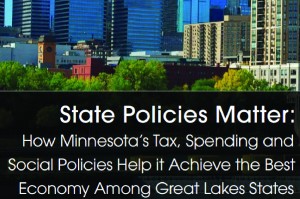
The Growing Michigan Together Council should look to Minnesota for the cold weather state population growth playbook. Conventional wisdom has had it for decades that Americans were abandoning cold weather states for the Sun Belt and the Mountain West. By and large that conventional wisdom is accurate, but not for Minnesota.
Minnesota has not lost a congressional seat for six decades. Each decade from 1960 on Minnesota has had 8 congressional seats. In 1960 Michigan had 19 congressional seats, today it has 13. Michigan has lost at least one seat in Congress each of the last five decades. The last time Michigan had as few as 13 congressional seats was the 1920s.
It’s not just Michigan, all the other Great Lakes states have lost congressional seats since 1960:
- Illinois from 24 to 17
- Indiana from 11 to 9
- Ohio from 24 to 15
- Wisconsin from 10 to 8
As have the other states that border Minnesota:
- Iowa from 7 to 4
- North Dakota from 2 to 1
- South Dakota from 2 to 1
Not losing a congressional seat since 1960 means Minnesota’s population has grown at near the same rate as the nation’s for the last six decades. Its 2022 population is 167 percent larger than it was in 1960. Over that same time period Michigan’s population has grown 128 percent. If Michigan’s population growth since 1960 had been the same of Minnesota’s, Michigan population would be around 13 million rather than the 10 million it is today.
Minnesota also is a national leader in retaining and attracting recent college graduates. The cohort that matters most to state’s and region’s future prosperity. A recent study found that Minnesota is one of only nine “brain-gain” states with 8 percent more recent college graduate residents compared to those who graduated from its college and universities. Michigan is a “brain-drain” state with 14 percent fewer college graduate residents compared to those who graduated from its college and universities.
So there is a cold weather state population growth playbook for Michigan policymakers to emulate. Which raises the question: What has Minnesota done to buck cold weather state depopulation?
In 2014 we asked Rick Haglund to answer that question. His report, State Policies Matter: How Minnesota’s Tax, Spending and Social Policies Helped it Achieve the Best Economy Among Great Lakes States, is as valid today as it was nine years ago. Yes the data in the report needs updating, but Rick’s description of the path Minnesota has taken for more than five decades is still accurate today. Rick’s conclusion:
Lawmakers and governors in many states, including Michigan, have focused primarily on cutting taxes and shrinking the size of their governments as the path to prosperous economies. As this report has shown in detail, Minnesota has traveled a different path. There is no question Minnesota is a high tax state—as stated earlier, its residents paid $2,145 (updated for 2021) more than Michigan residents in state taxes alone.
But it has largely invested that additional revenue in services and investments that matter in a knowledge-based economy. An educated workforce, efficient transportation systems, vibrant cities and metropolitan areas, and a secure safety net for those making the transition to a global economy all matter in creating a prosperous state.
Minnesota has made those necessary investments and enacted policies making the state welcoming to all. It really shouldn’t be surprising, then, that it has the strongest economy in the Great Lakes region and one of the most vibrant in the country.
Maybe most important is what isn’t part of the Minnesota playbook:
- Minnesota did not lower taxes. In fact as Rick documents, in 2013 when Michigan was slashing business taxes, Minnesota raised taxes on companies and the wealthy. In 1980 Minnesota had the 6th highest state taxes per capita in the country. Michigan ranked 13th. Minnesota’s state taxes per capita were 122 percent of Michigan’s. In 2021 Minnesota had the 5th highest state taxes per capita in the country. Michigan ranked 28th. Minnesota’s state taxes per capita were 163 percent of Michigan’s.
- Minnesota did not slash its safety net. As Rick wrote: “Many states have cut benefits to the poor and unemployed in the belief that these payments dissuade people from looking for paid work. Minnesota takes a different view. It has created one of the strongest safety nets in the country, spending generously on benefits to help those who have lost jobs or been stricken by poverty get back on their feet. That protective net has not trapped Minnesotans and turned them into a bunch of government-dependent slackers. Far from it.”
- Minnesota does not offer big incentives for economic development projects. Read the Minnesota Economic Development Resource Guide and you will not find any big incentive program like SOAR, Michigan’s new billions of dollars business incentive program.
Michigan has, of course, done the exact opposite. On a bipartisan basis accepting that high taxes, particularly on businesses are job killers, the state has anchored its economic development playbook on cutting taxes for at least three decades. And, also on a bipartisan basis, enacting one version after the other big economic development incentive programs. As well as slashing the state’s safety net in part on the belief that a more generous safety net discourages people from working.
At its core the Minnesota playbook for economic and demographic success has been higher taxes used for public investments to compete for talent by offering good schools from birth through colleges and creating places where people want to live by offering high quality basic services, infrastructure and amenities.
Minnesota has not only been a Great Lakes demographic success it also is a high-prosperity state. In 1979 Minnesota’s per capita income was one percent above the national average, Michigan was three percent above. In 2022 Minnesota’s per capita income is four percent above the nation’s; Michigan’s is 13 percent below. So as Michigan’s state taxes per capita declined from 13th highest in the nation to 28th the state’s per capita income declined by fifteen percentage points compared to the nation. While Minnesota gained three percentage points while staying a high tax state.
Minnesota focus on making public investments in education from birth through college and creating high quality of living communities combined with being welcoming to all is the foundation for its population and economic well being success. Minnesota has developed a policy playbook that makes preparing, retaining and attracting talent its economic development priority #1. That is exactly what is needed in today’s economy where talent attracts capital.







